May 15 - 21 2016: Issue 263
WIELICZKA SALT MINE
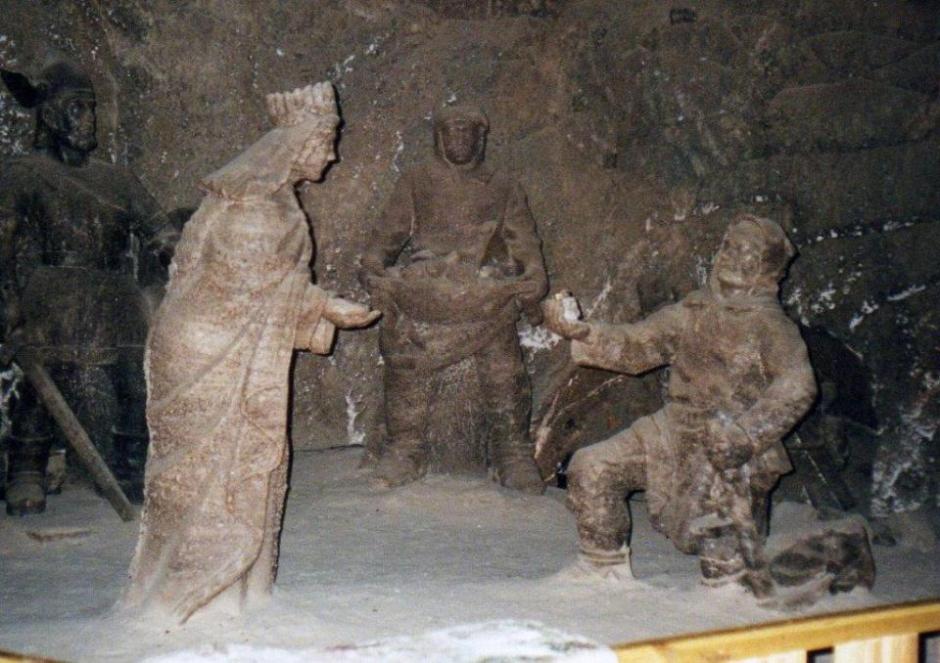
Salt sculpture - Offering a Tribute
WIELICZKA SALT MINE
By George Repin
The town of Wieliczka (vyeh-leech-kah) located about 15 Kms. southeast of Kraców in Southern Poland is famous for its deep salt mine which, in 1978, was included in the UNESCO list of World Heritage sites. The town was founded by a local Duke in the 12th Century to mine the salt.
Opened in the 13th Century the mine produced table salt continuously until 2007, although commercial mining was discontinued in 1996 because of low salt prices and some flooding in the mine. It was one of the world’s oldest salt mines when production was discontinued.
A labyrinth of 300 Kms of tunnels is distributed over nine levels, the deepest being 327 metres below the surface. Everything has been carved, in salt, by hand. Twenty two chambers connected by galleries, at a depth of 64 m. to 135 m. are open to the public by guided tour.
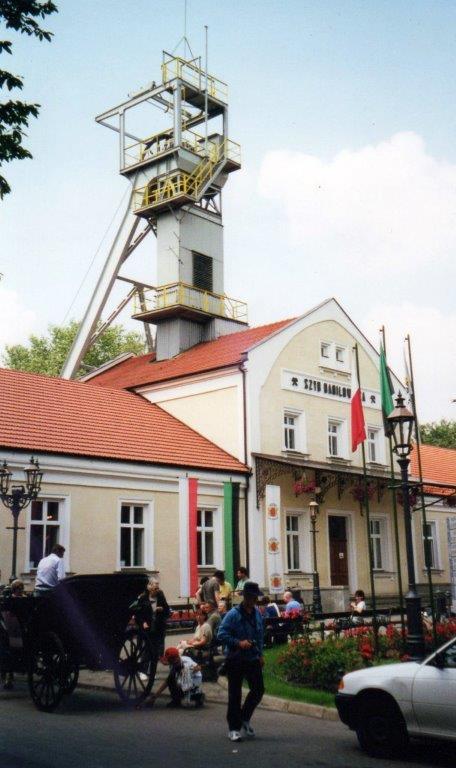
Main mine building with lift tower
There are four salt-hewn chapels, statues, bas reliefs and monuments all cut out and decorated by miners over the years. An outstanding showpiece is the ornamented Chapel of St. Kinga (Kaplica Św Kingi) measuring 54 m. by 18 m. and 12 m. high. 20,000 tonnes of rock salt were removed in its construction. Every element in the chapel, including altars, wall carvings and even chandeliers, is of salt.
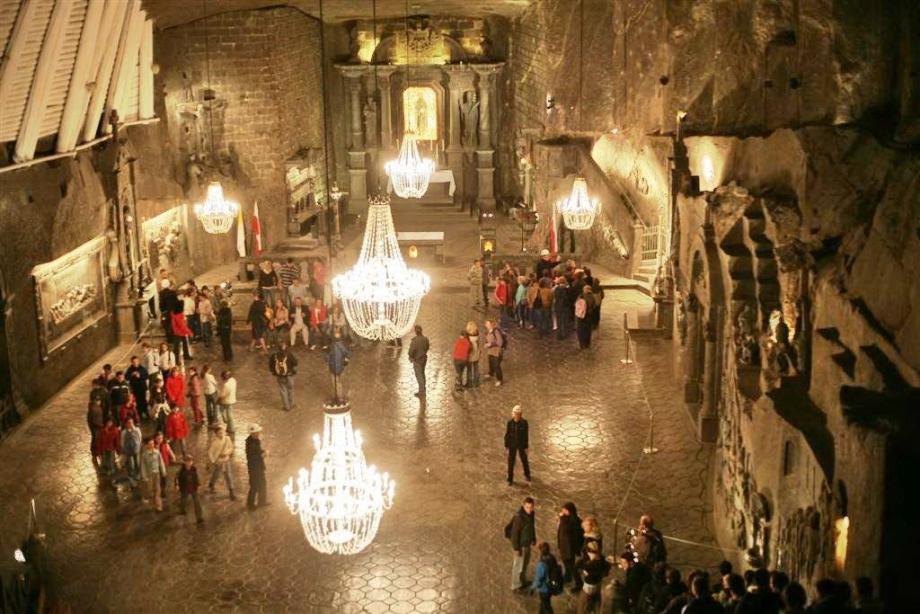
The Chapel of St. Kinga - photograph from Wikipedia
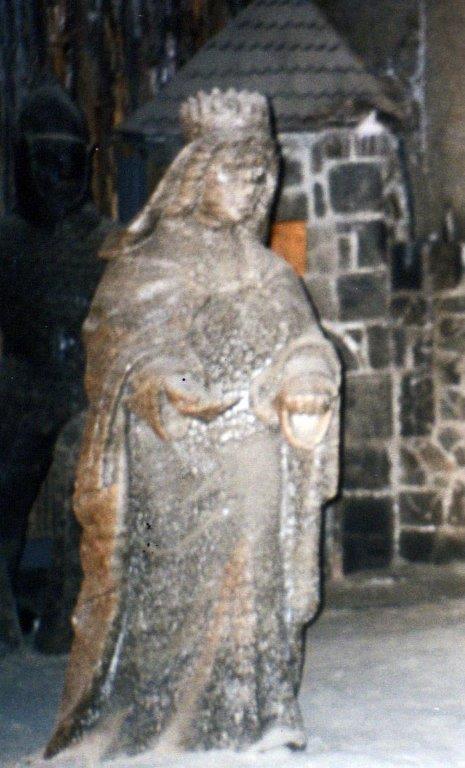
Salt sculpture - Standing Woman
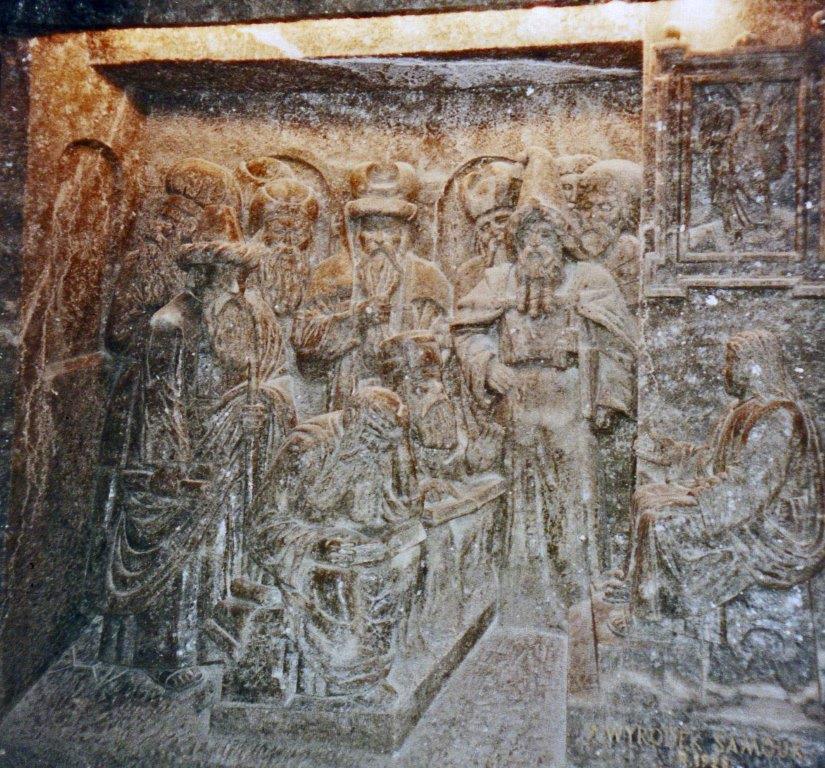
Salt sculpture - Bas relief of oriental figures in Chapel of St. Kinga
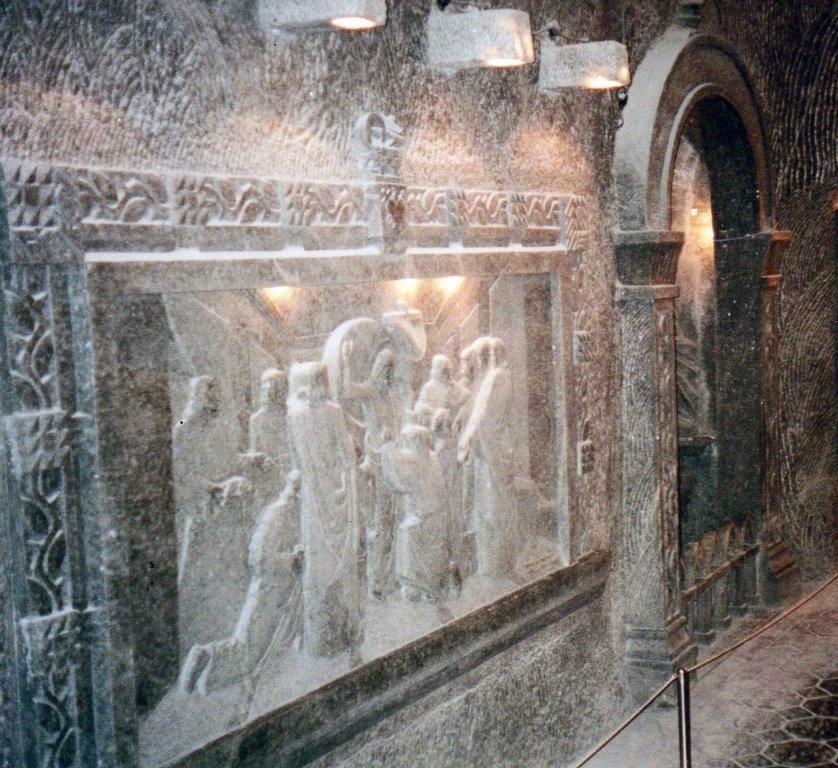
Salt sculpture - Wall decoration in Chapel of St. Kinga
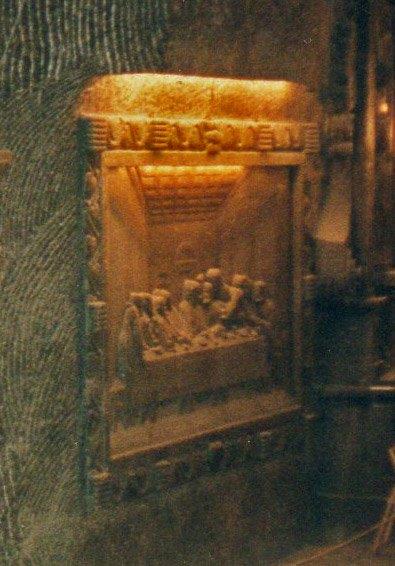
Salt sculpture - Illuminated panel in Chapel of St. Kinga
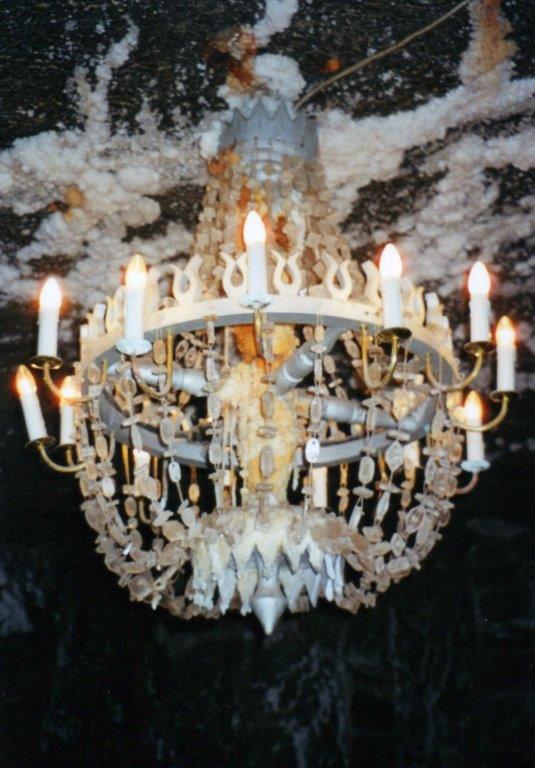
Chandelier -all decorative features carved from salt
The Wieliczka mine is sometimes referred to as The Underground Salt Cathedral of Poland.
Visitors enter the mine by a wooden staircase of 378 steps to the 64 m. (210 ft.) level where a 3 Kilometre (1.9 mile) tour of the mine’s corridors, chapels, statues and an underground lake starts – going down to the 135 m. (443 ft.) level. The tour takes in less than 2% of the mine’s passages. At the end of the tour an elevator takes the visitor to the surface,
Salt in the mine is not white and crystalline, as might be expected, but various shades of grey resembling unpolished granite. The deposit was formed in the Miocene Epoch, 13.6 million years ago.
The head office of the mine’s board from medieval times until 1945 was in the Castle in Wieliczka – the so-called The House Within the Saltworks – now the location of the Kraków Saltworks Museum.
Photographs, other than of the Chapel of St. Kinga, were taken by George Repin in 2000.
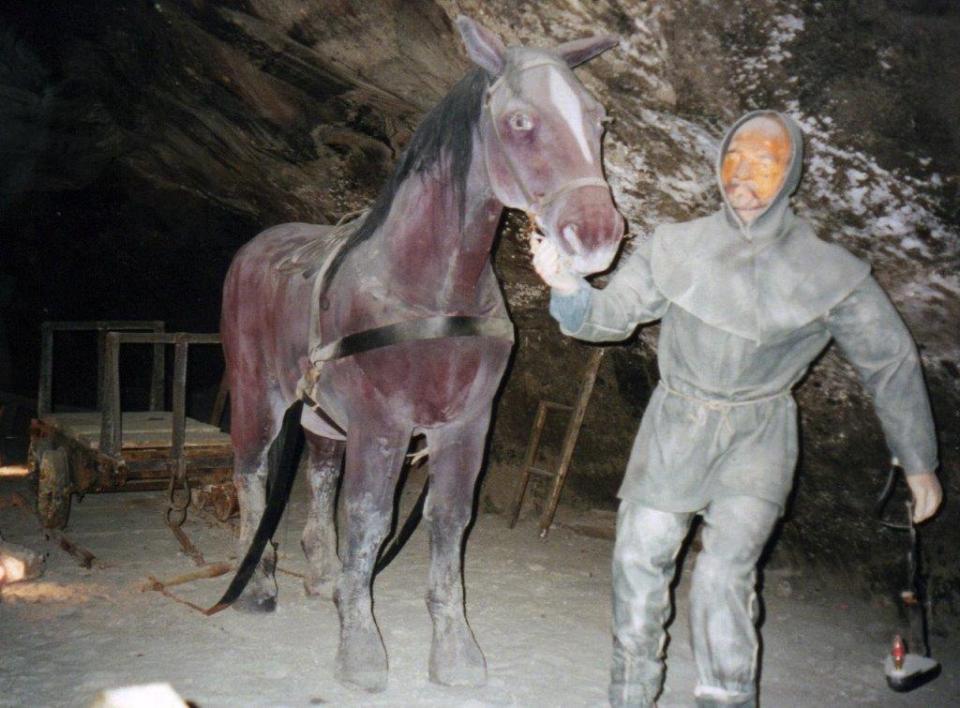
Salt sculpture - Man with Horse and Cart
Previous Reflections by George Repin
The Nineteen Thirties Remembering Rowe Street The Sydney Push Saturday Night at the Movies Shooting Through Like A Bondi Tram A Stop On The Road To Canberra City Department Stores - Gone and Mostly Forgotten An Australian Icon - thanks to Billy Hughes Crossing The Pacific in the 1930s Hill End The Paragon at Katoomba Seafood In Sydney How Far From Sydney? Cockatoo Island Over The Years The Seagull at the Melbourne Festival in 1991 Busby's Bore The Trocadero In Sydney Cahill's restaurants Medical Pioneers in Australian Wine Making Pedal Power and the Royal Flying Doctor Service Pambula and the Charles Darwin Connection Gloucester and the Barrington Tops A Millenium Apart Have You Stopped to Look? Gulgong Il Porcellino Olympia Durham Hall Sargent's Tea Rooms Pie Shops and Street Photographers The Ballet Russes and Their Friends in Australia Hotels at Bondi Alma Ata Conference - 1978 Keukenhof - 1954 The Lands Department Building and Yellowblock Sandstone The Goroka Show - 1958 A Gem On The Quay Staffa The Matson Line and Keepsake Menus Kokeshi Dolls The Coal Mine At Balmain The Hyde Park Barracks The Changing Faces Of Sydney From Pounds and Pence to Dollars and Cents Nell Tritton and Alexander Kerensky Making A Difference In Ethiopia William Balmain J C Bendrodt and Princes Restaurant Azzalin Orlando Romano and Romano's Restaurant Waldheim Alcohol in Restaurants Before 1955 King Island Kelp The Mercury Theatre Around Angkor - 1963 Angkor Wat 1963 Costumes From the Ballets Russe Clifton at Kirribilli Chairman Mao's Personal Physician The Toby Tavern The MoKa at Kings Cross The Oceaographic Museum in Monaco The Island of Elba Russian Fairy Tale Plates Meteora Souda Bay War Cemetery Barrow, Alaska Cloisonné Tripitaka Koreana Minshuku The Third Man Photographs and Memories Not A Chagall! Did You Listen? Did You Ask? Napier (Ahuriri, Maori) New Zealand Borobudur Ggantija Temples Plumes and Pearlshells Murano University of Padua Ancient Puebloe Peoples - The Anasazi Pula The Gondolas of Venice Cinque Terre Visiting the Iban David The Living Desert Bryce Canyon National Park Aphrodisias The Divine Comedy Caodaism Sapa and local Hill People A Few Children Cappadocia Symi Jean-Marie Tjibaou Cultural Centre Aboriginal Rock Art on Bigge Island ANZAC Cove (Ari Burnu) 25 April, 1997 Hotere Garden Oputae Children of the Trobriand Islands Page Park Market - Rabaul Rabual Kotor, Montenegro Galleries of Photographs I Lascaux Galleries of Photographs II The Cathedral of St. James – Šibenik, Croatia Ivan Meštrović - Sculptor Delphi Gallery of Photographs III The Handicrafts of Chiang Mai Raft Point San Simeon - "Hearst Castle" Floriade - The Netherlands - 1982 Russian New Year Mycenae "Flightseeing" Out Of Anchorage Alaska The White Pass and Yukon Route Totem Poles Tivkin Cemetery Krka National Park - Croatia Tavistock Square and the BMA Orthodox Easter
Copyright George Repin 2016. All Rights Reserved.